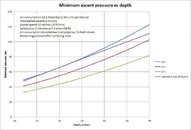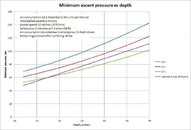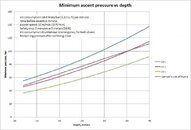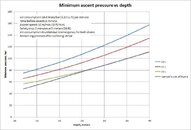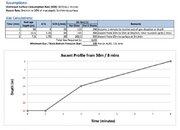Dry suit and cold water? Not exactly my idea of a basic level scuba dive.
I think others have pointed out that your views are limited in their scope. On the east coast of Canada, for example, I know a shop that starts OW punters off in drysuits in the pool.
If I was to head for the surface at 110 b from 30 m with a 12 L tank I'd surface with about 90 b which is nearly double the required 50 b. I've never heard anyone apart from a few people on this forum pushing the idea that divers should surface with 90 b or 1300 psi. Anyone else think that for a straight forward ascent from 30 m this sounds decidedly whacky.
Depends how are you calculate your gas needs?
Let's make this simple and put it into a context that sport divers might adopt.
We can use an average SAC of 14 l/min (which is low for most divers but whatever). Travel from 30 m to the safety stop at three or four metres should take a minimum of three minutes, more like five to seven for a careful diver (and we are promoting careful diving where the liklihood of "unearned" DCS is managed... yes?). So let's use five minutes. Mean depth for those five minutes is 16.5 m which nets a ambient pressure of 2.65 bar. The consumption will therefore be 185.5 litres... WITHOUT any dive factor. So, let's say that 185 l becomes a more realistic 200 litres. The diver executes a safety stop because a dive beyond 18 m certainly warrants one. So let's say three minutes at three metres... Gas needs = 55 litres. Our diver would need a few additional litres to surface after completing his/her stop. Make that 55 litres 60.
Total needs for a single diver doing what works = 260 litres. In a 12 l cylinder, 260 litres equals about 21 bar.
So, if the goal is to surface with 50 b, our diver has to leave the bottom with about 71-75 bar.
THESE NUMBERS ASSUME no trouble during ascent: A low SAC rate: A low Dive Factor (workload, stress, mild temperature, buoyancy control etc... and frankly, for a sport diver, these may be safe or unsafe assumptions. I do not know who the divers are. I would say that if I were doing this dive with any of my mates, the numbers in my example would be golden. Couple of reasons.
1) I don't dive with muppets so an OOA is not likely
2) if someone has a gas emergency, the surface with 50 bar is out the window... that gas may get used on the way up
HOWEVER, what if the punters in our example are charlie foxtrots? Leaving the bottom with 75 bar might mean they will be on seeds and stems when they surface.
Your take-home messages from all the crap contained in this thread is surely that gas management is not so complex that it can be ignored; and secondly and perhaps most importantly THERE ARE LOTS OF VARIABLES. One can choose to take that into account or ignore it. Seems most of the folks responding to your post choose the former.



